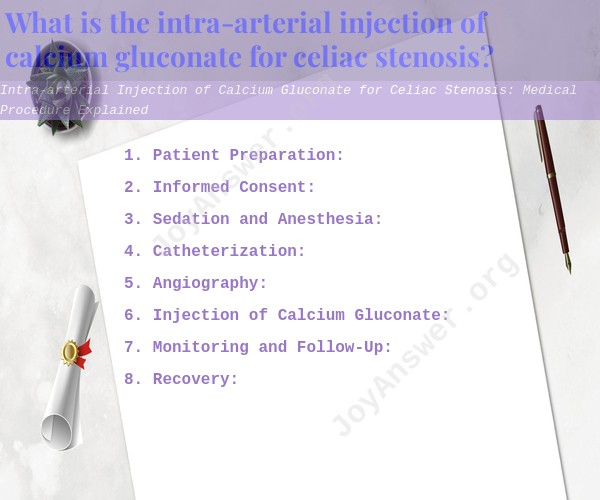What is the intra-arterial injection of calcium gluconate for celiac stenosis?
Intra-arterial injection of calcium gluconate is a medical procedure used to treat celiac stenosis, a condition where the celiac artery becomes narrowed or blocked. The celiac artery is a major blood vessel that supplies blood to the stomach, liver, and other abdominal organs. When this artery is narrowed due to stenosis, it can lead to reduced blood flow to the organs it supplies, causing various symptoms and complications.
The procedure involves delivering a solution of calcium gluconate directly into the affected artery to dilate and widen it, thereby improving blood flow. Here's an explanation of the medical procedure:
1. Patient Preparation: Before the procedure, the patient is typically given a thorough evaluation, which may include medical history, physical examination, and imaging studies such as angiography or computed tomography angiography (CTA). These tests help identify the presence and extent of celiac artery stenosis.
2. Informed Consent: The patient receives detailed information about the procedure, its potential risks, benefits, and alternatives. Informed consent is obtained before proceeding with the intra-arterial injection of calcium gluconate.
3. Sedation and Anesthesia: Depending on the patient's condition and the complexity of the procedure, local anesthesia or conscious sedation may be administered to keep the patient comfortable during the process.
4. Catheterization: The procedure is typically performed by an interventional radiologist or an interventional cardiologist. A thin, flexible tube called a catheter is inserted into a blood vessel, usually in the groin area, and carefully navigated through the arterial system to reach the celiac artery.
5. Angiography: Once the catheter is in position, contrast dye is injected through the catheter into the celiac artery, and X-ray images (angiograms) are taken. These images help the interventionalist visualize the stenosis and determine the extent of the narrowing.
6. Injection of Calcium Gluconate: After obtaining a clear view of the stenosis, a solution containing calcium gluconate is injected directly into the narrowed area of the celiac artery. Calcium gluconate acts as a vasodilator, meaning it relaxes and widens the blood vessel, improving blood flow to the affected organs.
7. Monitoring and Follow-Up: The patient is closely monitored throughout the procedure and during the recovery period. After the injection, additional angiograms may be taken to assess the success of the treatment.
8. Recovery: In most cases, the procedure is well-tolerated, and patients can typically go home on the same day or the following day. Recovery time may vary based on individual factors, but patients are usually advised to rest and avoid strenuous activities for a short period.
It's important to note that intra-arterial injection of calcium gluconate is a specialized medical procedure and is not suitable for all cases of celiac artery stenosis. The decision to perform this procedure is based on the patient's specific medical condition, the severity of the stenosis, and other individual factors. As with any medical intervention, there are potential risks and complications associated with this procedure, which should be thoroughly discussed with the healthcare provider.












